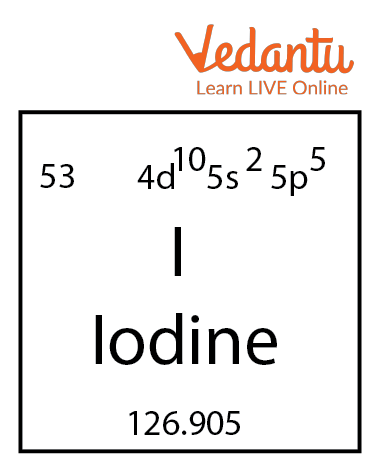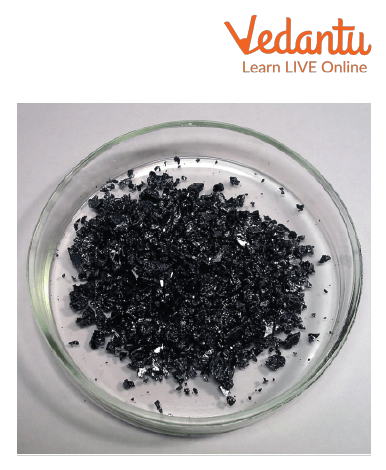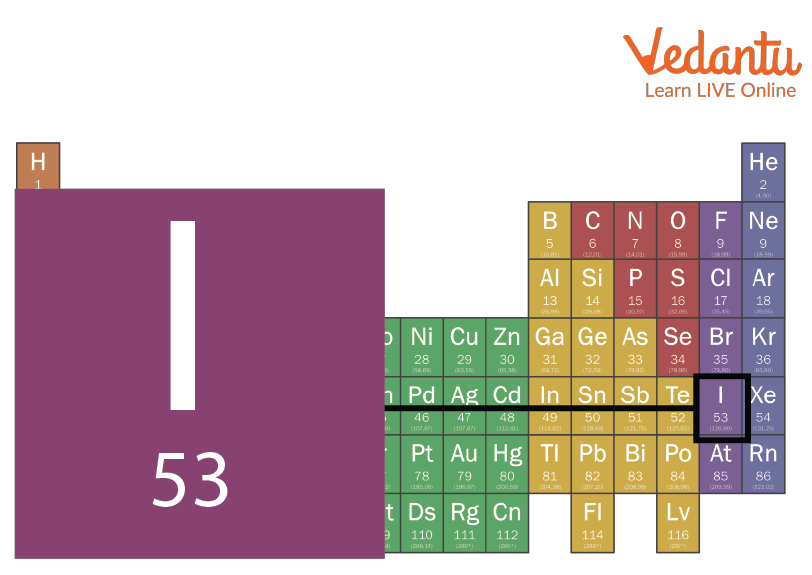




About: Sulfate or Iodine
Iodine is a chemical element. The symbol for Iodine is I. It's atomic number is 53. It lies in the 17th group of the periodic table which is known as the halogen group. It is the heaviest of stable halogens. It is a non metal. Iodine was discovered by French chemist Bernard Courtois in 1811. It's name was given by Joseph Louis Gay- Lussac. Read further to know more about iodine, its properties, uses and more. Down below is the image of the iodine periodic table.

Iodine Periodic Table Position
Occurrence of Iodine Element
Iodine is not found in nature. It is found in seawater as iodide ion. It is also found in seaweeds, oysters and cod livers. Iodine is also found in the human body in thyroxine which is produced by the thyroid gland. Natural occurring isotope of iodine is iodine 127, a radioactive isotope is iodine 131. Iodine 129 changes from radioactive form to nonradioactive in millions of years. Iodine occurs in many oxidation states which are iodide, iodate and various periodate anions. Iodate minerals, brackish water from oil and salt wells are the main sources of iodine. The iodine element is a chemical element , a member of the halogen element.

Iodine Crystals
Position of Iodine
Iodine is a non-metal that lies in group 17 that are halogens and period 5. It lies below Bromine (Br) and above Astatine (At), to the right of Tellurium (Te), and to the left of Xenon[Xe]. According to its position, it is non metal and a halogen. Most of the chemical and physical properties of iodine are decided by its position on the periodic table such as metallic or non metallic character, electronegativity, enthalpy, etc.

Physical Properties of Iodine
The physical properties of iodine are discussed below.
Iodine is non-metal and solid at room temperature.
It is dark, shiny, grey-black in colour.
Its melting point is
Its boiling point is
It is the most electropositive halogen.
Chemical Properties of Iodine
The chemical properties of iodine are listed below.
Its chemical properties are much similar to fluorine, chlorine and bromine.
It sublimes easily to a deep violet vapour.
Iodine is highly corrosive.
It dissolves slightly in water.
Iodine is a poisonous halogen.
Uses of Iodine
Some of the common uses of iodine are as follows:
Iodide salts are used in pharmaceuticals and disinfectants.
Iodine reduces thyroid hormone and can kill fungus and bacteria.
Iodine is used to make polarising filters for LCDs.
Radioiodine can be a possible treatment option for thyroid cancer.
It also helps the cells to make protein.
The commercial use of iodine is in photography.
Fun Facts About Iodine
The majority of our iodine comes from milk.
Iodine controls our metabolic rate.
Our brains require iodine.
It's a fantastic antiseptic.
Cancer can be cured with radioactive iodine.
It was employed in the creation of the earliest photos.
In order to check for starch, iodine is needed.
It can be used to keep paint from fading.
Solved Questions
1. What is the electronic configuration of iodine?
Ans: The electronic configuration of iodine is [Kr]
2. What is the natural colour of iodine?
Ans: Iodine is nearly black or grey-black in colour.
3. What is iodine on the periodic table?
Ans: Iodine is an atomic number 53 chemical element with the symbol I. Iodine is a solid at room temperature and is categorised as a halogen.
4. Where is iodine on the periodic table?
Ans: Iodine (I) is a chemical element that belongs to Group 17 of the periodic table, also known as the halogen elements.
Conclusion
Iodine is a non-metallic solid element that lies in group 17, which is known as the halogen group, and period 5 of the periodic table. Along with earth's crust, it is found in seawater. It mainly has 3 isotopes naturally and is radioactive. Out of the halogen family, it is the least abundant. It plays an important role in the drug industry. Seaweed contains high concentrations of iodine. It is an essential mineral for human health.
FAQs on Facts About Iodine ( I )
1.What are the sources to get iodine in your diet?
Dairy products like cheese, milk and yoghurt and eggs are good sources of iodine.
2. What is the pH of iodine?
The pH value of iodine is 7.4.
3. Why is iodine kept in dark bottles?
The iodide ions are oxidised to iodine by atmospheric oxygen.
4. What food is rich in iodine?
Iodine is rich in seaweed, fish, dairy products, eggs, beef liver, chicken, etc.
5. What are the two types of iodine?
The two types of iodine are elemental diatomic iodine and ionic monoatomic iodide.









